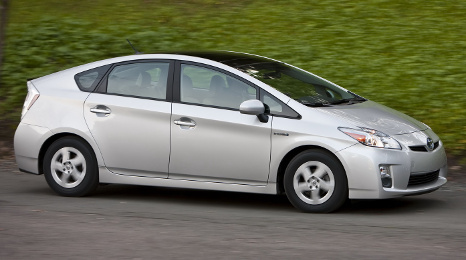So much for the theory that rising wholesale volume would cause used-vehicle prices to soften — or even crash, as some doomsday observers feared.
The Manheim Used Vehicle Value Index climbed to a new record high in May as analysts determined wholesale used-vehicle prices (on a mix-, mileage- and seasonally adjusted basis) rose 2.6 percent month-over-month. The movement brought the index reading to 127.9, which is a record high and represented a 2.8-percent increase from a year ago.
The previous index high came last September when it was 126.9.
“The May index result challenges concerns that increasing wholesale supplies from near peak off-lease volumes and rising rental volumes would lead to rapidly declining used-car values. Indeed, the opposite appears to be happening,” new Cox Automotive chief economist Jonathan Smoke said in commentary that accompanied the latest index update.
“Higher commercial volumes at auction are providing the used vehicle market with quality and choice that offers a compelling value to consumers,” Smoke continued.
“Dealers responded to the consumer demand for used vehicles by purchasing the most vehicles at Manheim for the month of May since 2008,” he went on to say. “Year-over-year growth in sales outpaced the growth in inventory, which helped result in the record high index value. A slightly younger mix of vehicles also likely contributed to the record index level.”
Looking deeper at the six vehicle segments Manheim tracks for its update, analysts spotted May prices for pickups and vans helped to lead the charge to the new index record as they rose 9.1 percent and 7.3 percent, respectively, on a year-over-year basis.
Only the midsize car category dropped year-over-year, declining by 2.4 percent in May.
Within the off-rental market, Manheim determined the average price for rental risk units sold at auction in May dipped 2 percent year-over-year and 1 percent compared to April.
Analysts also mentioned SUV/CUVs accounted for 29 percent of rental risk sales in May versus 25 percent during the same month last year. Compact cars’ share fell from 31 percent to 27 percent.
Manheim added that the average mileage for rental risk units in May (at 38,900 miles) settled 9 percent below a year ago.
Along with some other anecdotes about what’s happening in the lanes, the latest Black Book Market Insights report indicated the truck segment as a whole is remaining fairly stable.
Editors found that three vehicle categories within the truck segment increased their values last week, including the sub-compact crossover, midsize crossover/SUV and full-size pickup.
“Small cars continued to decline in value at a faster clip while large SUV and pickup truck values remained fairly stable last week,” said Anil Goyal, senior vice president of automotive valuation and analytics at Black Book.
Volume-weighted, editors determined overall car segment values declined by 0.46 percent last week. In comparison, the market values had decreased on average by 0.32 percent per week in the previous four weeks.
In car segments, Black Book reported that sub-compact car and compact car segments performed the worst, decreasing by 0.88 percent and 0.97 percent, respectively.
Again analyzing volume-weighted data, editors found that overall truck segment values (including pickups, SUVs and vans) decreased by just 0.08 percent last week, better than the average decrease of 0.21 percent per week during the previous four weeks.
In truck segments, Black Book pointed out sub-compact luxury crossover/SUV and compact luxury crossover/SUV values dropped the most by 0.71 percent and 0.42 percent, respectively.
Turning next to what Black Book collected from its representatives scattered at more than 60 auctions nationwide, an auction general manager in Pennsylvania shared this assessment: “Our business has been good. I wish we had more vehicles to quench the dealer demand, but the positive sales conversions have been the norm, which is good.”
Meanwhile down in Georgia, Black Book’s lane watcher reported this assessment: “Online auctions in Florida (dealer consigned) and Pennsylvania (commercial) showed similar results. There was not a lot of interest in the vehicles, which resulted in more no-sales than usual.”
In nearby North Carolina, the story from the lanes went like this: “Volume was down but the inventory that was here sold well with very few no-sales.”
And finally out West in Washington, the auction beat evidently goes on as this recap indicated: “Normal sale this week with an average number of vehicles. Prices remain steady but dealers seem to be getting more conservative, not only in what they will buy but what they will pay.”
If you have certified pre-owned units with alternative powertrains, the spring issue of Perspective from J.D. Power Valuation Services (formerly NADA Used Car Guide) offered some insight into why it might be difficult to turn that vehicle.
Before it became that CPO model, J.D. Power analysts explained that alternative segments generally have weaker demand and higher incentives than their gasoline-powered counterparts on the new side of the market.
“These two hindrances carry over directly to the used market, which means prices of used alternative powertrain models fall at much higher rates than for their gasoline counterparts,” analysts said in the report.
“The higher rate of depreciation means electric vehicles, plug-in hybrid and traditional hybrid retained value is frequently inferior to competitive gas models,” they continued.
Looking at the most recent 3-year-old retention figures by powertrain type (3-month average from March to May of this year), analysts noticed gasoline equipped models have retained at a rate of 52.1 percent, followed by hybrids at 46.4 percent.
Trailing much further behind, J.D. Power found that plugin hybrid and electric vehicle value retention reached 36.9 percent and 26.9 percent, respectively.
“Looking back, 2016 and 2015 retention results for the same period were similar. However, electric vehicle retention was more volatile because of new models being added,” analysts said in the report, which can be downloaded here.
Impact of fuel prices
J.D. Power also mentioned that what consumers are paying at the pump isn’t giving them much of an incentive to take that CPO unit off your store’s hands.
Analysis cited the forecast from the U.S. Energy Information Administration (EIA) that predicted fuel prices are expected to grow from roughly $2.30 per gallon in February to $2.51 per gallon in July before falling to $2.24 per gallon by December. Looking further out, the EIA expects prices to average $2.40 per gallon in 2018 and $2.44 per gallon in 2018.
“With average regular grade gas prices expected to remain around or under $2.50 per gallon in the U.S. over the short-term, there is little reason to believe that buyers who are sensitive to high gasoline expenses will be inclined to choose an alternative powertrain vehicle over a traditional gas-powered automobile due to the cost of fuel,” J.D. Power said in the report.
“However, it’s entirely possible that even with low gas prices expected in the coming years, some environmentally conscious consumers will continue to actively purchase electrics or plug-in hybrids,” analysts added.
Black Book’s Used Vehicle Retention Index for May dipped both on a sequential and year-over-year basis.
With four car segments sustaining drops, the May index reading came in at 112.3, which was down by 0.7 percent from the April mark of 113.1. The May reading also represented a 5.6-percent decline versus the same month last year.
The Black Book Used Vehicle Retention Index is calculated using Black Book’s published wholesale average value on 2- to 6-year-old used vehicles, as percent of original typically-equipped MSRP. Black Book insisted the index offers “an accurate, unbiased view” of the strength of today’s used wholesale market values.
The Index showed a decline as car and truck segments saw increased depreciation in May following a strong spring selling season during April. The Index saw a slight bump from 113.0 in March to 113.1 in April, the first time the Index saw an increase dating back to January 2015.
The firm explained several car segments saw noticeable declines in the Index from the previous month. Sub-compact cars fell 1.6 percent while full-size cars dropped 0.7 percent. Mid-size cars edged 0.6 percent lower while and sporty cars dropped by 1.0 percent.
Conversely, Black Book noticed premium sporty cars rose 0.4 percent.
On the trucks side, Black Book determined small pickups increased 0.5 percent from the previous month. While full-size luxury utilities ticked up just 0.1 percent, full-size pickups held steady, according to Black Book.
“There is not a lot of surprise in the May numbers, particularly after seeing arguably the strongest spring-season lift on record over the last three years in April,” said Anil Goyal, senior vice president of automotive valuation and analytics for Black Book.
“It is expected that we will see more declines in the Index in the months ahead as we move deeper into the year, particularly driven by softness among car segments,” Goyal continued.
The index dates back to January 2005, where Black Book published a benchmark index value of 100.0 for the market. During 2008, the index dropped by 14.1 percent while during 2016, the index by lost 6.4 percent.
During 2011, the index rose strongly from 113.3 to 123.0 by the end of the year as economy picked up steam and used-vehicle values rose higher. It continued to remain relatively stable, rising slightly till May of 2014 when it hit a peak of 128.1.
To obtain a copy of the latest Black Book Wholesale Value Index and chart, click here.
Going into Memorial Day weekend, Black Book learned dealers weren’t overly eager to spend their floor plan funds as vehicle depreciation trends told editors “that summer is fast approaching.”
According to the latest Black Book Market Insights report, editors found that car segments are picking up more weekly depreciation compared with trucks, “signaling that summer is fast approaching.” The report also touched on midsize cars, which have been experiencing some of the highest depreciation among all car segments as of late.
“Midsize cars depreciated at a higher rate than other car segments for the second week in a row. Dealers are reporting slow retail and tightening in subprime credit,” said Anil Goyal, Black Book’s senior vice president of automotive valuation and analytics.
Volume-weighted, Black Book indicated overall car segment values decreased by 0.41 percent last week, worse than the average weekly decrease of 0.31 percent in values over the previous two weeks.
Editors determined the midsize car, full-size car, sub-compact car and luxury car segments declined the most by 0.64 percent, 0.60 percent, 0.50 percent and 0.49 percent, respectively.
Again looking at volume-weighted information, Black Book noticed overall truck segment (values including pickups, SUVs and vans) decreased by 0.28 percent last week, slightly better than the average weekly decrease of 0.34 percent in values over the previous two weeks.
Editors found midsize crossover/SUV and compact van segments declined the most by 0.58 percent and 0.54 percent, respectively.
Representatives in lanes noticed dealers watched scores of vehicles roll over the block without adding them to their inventory. The first two reports conveying this trend came out of the Southeast.
Black Book’s lane watcher in Georgia reported, “Dealers were not in a rush to buy here today. Two dealers that I check in with routinely had extremely low numbers of purchased units.”
And out of Florida, a similar chorus: “Lots of no-sales today but the biggest surprise was that a lot of trucks struggled to get to the money or didn’t sell at all.”
And in Michigan, Black Book uncovered at least one reason why dealers might not be so ready to add lots of vehicles into inventory.
“The market is rather flat here. Retail remains sluggish and customers with challenged credit are having a really tough time purchasing transportation,” Black Book personnel reported from a Michigan sale.
Elsewhere around the country, the story wasn’t quite so bleak in the lanes where Black Book attends about 60 auctions on a regular basis. An upbeat assessment come from Indiana.
“Pretty good sale here today,” Black Book’s lane watcher in the Hoosier State said. “Retail has been a little slow due to lots of rain but the nice weather seems to have brought out the buyers.”
Down in Texas, some positive assessments there, too, with the Black Book representative stating, “We had a good sale today, which was good to see. Buyers were engaged and the values were holding steady. The rental vehicles performed better than they have the last couple of weeks.”
And finally, the sentiment out of Colorado might have just summed up the entire wholesale situation when the watcher said, “Just an average sale this week although it was better than last week. The market here is definitely settling down for the summer months.”
The spring season in the wholesale vehicle market has passed and auction values have returned to seasonal depreciation patterns, says Black Book.
Car segment values were down 0.36 percent last week and trucks fell 0.47 percent, according to the latest Black Book Market Insights report.
This just a couple weeks after a stronger than expected April.
“After a short spring season when the values of small cars rose, subcompact and compact car segments are starting to see a decline,” Anil Goyal, who is Black Book’s senior vice president of automotive valuation and analytics, said in a news release.
“There is now anxiety among buyers about paying too much in the auction lanes,” he said.
In the two weeks prior to last, cars had depreciated an average of 0.26 percent, while trucks were close to being flat.
Among cars, the biggest drop-off this past week was for the midsize car segment (down 0.66 percent). For trucks, it was the subcompact luxury crossover (down 1.28 percent).
Subcompact crossovers were the lone truck segment to increase, albeit very slightly (0.08 percent). Likewise, sporty cars were the only cars to climb (0.01 percent).
This week’s report also includes a comparison between the 12-month depreciation rates of cars and trucks.
In May 2016, the average wholesale price on a 2- to 6-year-old car was $13,690. That has since declined 19.7 percent to $10,991.
As for trucks, the price a year ago was $20,811. In May of this year, it’s down 14.9 percent at $17,714.
While determining that overall April wholesale prices moved higher both sequentially and year-over-year, KAR Auctions Services chief economist Tom Kontos drilled deeper into the latest data, focusing on what he called “two bellwether model classes.”
And what he found tells a much different story about what happened in a particular pocket of the wholesale space last month.
First, let’s get to the overall metrics. According to ADESA Analytical Services’ monthly analysis of wholesale used vehicle prices by vehicle model class, wholesale used vehicle prices in April averaged $11,141 — up 2.2 percent compared to March and up 2.5 percent relative to April of last year.
Kontos mentioned that compact, midsize and luxury cars all showed year-on-year price declines of 2.0 percent or more, while most of the truck segments registered significant year-over-year gains.
“Average wholesale prices in April were up on both a month-over-month and year-over-year basis,” he continued in his latest Kontos Kommentary. “As has been stated repeatedly in previous months, however, much of these supposed increases in used vehicle values are the result of strength in truck prices and growth in off-lease volumes.
“An analysis of sales prices by sale type, model-year age, mileage and model class segment reveals that prices actually fell in April on both a month-over-month and year-over year basis for two bellwether model classes,” Kontos said. “This drill-down is more reflective of the downward pressure of supply growth on used vehicle values.”
Kontos found that when he broke the data down by age, he noticed that prices softened 1.3 percent for 3-model-year-old units; what he considers to be a good proxy for off-lease units. Here is what else Kontos discovered:
—Prices for midsize cars in this age range dropped by $744 or 6.3 percent year-over-year from $12,459 to $11,715
—Prices for midsize SUVs/CUVs in this age range dipped by $753 or 3.6 percent year-over-year from $20,945 to $20,192
“These results are based on holding constant for sale type, model-year age, mileage and model class segment,” Kontos said. “Midsize cars and midsize SUVs/CUVs are among the highest-selling model classes at auction and are good benchmarks for overall market performance.”
Looking at other portions of KAR’s latest information showed that average wholesale prices for used vehicles remarketed by manufacturers ticked up 2.5 percent month-over-month and 3.7 percent year-over-year.
Analysts also noticed prices for fleet/lease consignors edged 1.5 percent sequentially and 3.2 percent annually.
Furthermore, the company mentioned average prices for dealer consignors climbed 5.1 percent versus March and 3.9 percent versus April of last year.
As previously reported by Auto Remarketing, Kontos closed his latest analysis by noting April certified pre-owned sales information from Autodata Corp., which indicated April sales inched up 0.7 percent year-over-year but softened a bit sequentially (down 3.6 percent).
Kontos discussed the market further in the video available here and at the top of the page.
ADESA Wholesale Used-Vehicle Price Trends
| |
Average |
Price |
($/Unit) |
Latest |
Month Versus |
| |
April 2017 |
March 2017 |
April 2016 |
Prior Month |
Prior Year |
| |
|
|
|
|
|
| Total All Vehicles |
$11,141 |
$10,904 |
$10,866 |
2.2% |
2.5% |
| |
|
|
|
|
|
| Total Cars |
$8,968 |
$8,921 |
$9,044 |
0.5% |
-0.8% |
| Compact Car |
$6,805 |
$6,732 |
$7,003 |
1.1% |
-2.8% |
| Midsize Car |
$7,962 |
$8,006 |
$8,127 |
-0.6% |
-2.0% |
| Full-size Car |
$8,504 |
$8,346 |
$7,860 |
1.9% |
8.2% |
| Luxury Car |
$13,317 |
$13,235 |
$13,828 |
0.6% |
-3.7% |
| Sporty Car |
$14,694 |
$14,131 |
$14,415 |
4.0% |
1.9% |
| |
|
|
|
|
|
| Total Trucks |
$13,187 |
$12,825 |
$12,819 |
2.8% |
2.9% |
| Minivan |
$9,060 |
$9,012 |
$8,582 |
0.5% |
5.6% |
| Full-size Van |
$13,005 |
$13,009 |
$13,457 |
0.0% |
-3.4% |
| Compact SUV/CUV |
$11,083 |
$10,894 |
$11,033 |
1.7% |
0.5% |
| Midsize SUV/CUV |
$11,773 |
$11,455 |
$11,619 |
2.8% |
1.3% |
| Full-size SUV/CUV |
$14,085 |
$13,421 |
$13,221 |
4.9% |
6.5% |
| Luxury SUV/CUV |
$19,055 |
$18,343 |
$19,121 |
3.9% |
-0.3% |
| Compact Pickup |
$9,326 |
$8,793 |
$8,674 |
6.1% |
7.5% |
| Full-size Pickup |
$16,520 |
$16,142 |
$15,903 |
2.3% |
3.9% |
Source: ADESA Analytical Services.
Attributed in part to what analysts see as struggles to turn new models, J.D. Power Valuation Services’ seasonally adjusted used vehicle price index fell for the 10th straight month, leaving the reading at the lowest level since September 2010.
J.D. Power Valuation Services (formerly NADA Used Car Guide) reported in the May issue of Used Car and Light Truck Guidelines that its April index slipped 0.4 percent to 109.9, a figure 7.1 percent below April of last year when it stood at 118.3.
Prices of wholesale used vehicles up to eight years in age fell by 1.5 percent in April, a figure analysts noted was directionally in line with J.D. Power Valuation Services’ expectations for the month. April’s reading ended up nearly identical to the month’s 1.4-percent decline recorded in 2016.
Looking back over the past three years, analysts pointed out that April has averaged similar losses of around 1.2 percent.
“While April’s losses were consistent with historic norms, the used market continues to experience negative pressure from a struggling new market,” analysts said in the report. “New-vehicle inventory reached a considerable 76 days of supply, while new sales fell 4.9 percent (the daily sales rate declined 1.2 percent) compared to the same period in 2016.
“Making things worse, automakers found themselves growing incentives by an average of 13.6 percent per unit in an attempt to entice buyers and boost sales,” they continued.
Turning their focus back on used vehicles, analysts explained in the report that small cars led mainstream losses at the segment level. J.D. Power Valuation Services determined subcompact and compact car wholesale prices each fell by around 2.5 percent, which was about a half-point worse than the pair’s previous three-year average of 1.9 percent.
Analysts also mentioned April’s movement wiped out most of the 3.1-percent increase in prices the two segments gained in March.
The report indicated large utilities and midsize cars were the only other two mainstream segments that experienced declines greater than the industry average in April.
What analysts called “out of character for the period,” large utility prices fell by 2.3 percent, or 2.1-percentage-points worse than the segment’s previous three-year average decline of 0.2 percent.
However, losses for midsize cars were in line with “what’s typically recorded for the segment in April,” according to the report. During the past three years, analysts recapped that midsize car prices have declined by an average of 1.9 percent in April.
The report went on to mention losses for remaining mainstream segments ranged from 1.4 percent for compact utilities to 0.1 percent for large pickups.
Analysts pointed out the only non-luxury segment that experienced a lift in prices for the month was midsize pickups.
“Prices in this efficient utilitarian-focused group continue to be strong,” analysts said in the report, while adding that in April prices in this segment ticked up by 0.7 percent. Auction volume for this segment also increased by 4 percent in the most recent 4-week period.
“Historically, prices of midsize pickups have been softer during this time of the year,” the report acknowledged.
On the luxury side of the market, the report goes on to note segment prices were strong across the board with the exception of luxury large cars, which experienced a decline of 4.4 percent.
“Historically, prices for the luxury large car segment have been more volatile than other luxury peers,” analysts said. “That stated, the month’s decline was quite a bit more severe than the group’s previous three-year April average of 1.9 percent.
“Among other luxury segments, prices were relatively unchanged for luxury compact cars, luxury mid-size cars, as well as luxury large utilities,” analysts went on to say.
The combination of price movements and softening lane activity means one thing, according to Black Book. The spring market appears to have fully bloomed.
The latest Black Book Market Insights report showed both car and truck segments seeing higher depreciation than the last several weeks, both dropping 20 percent and 25 percent in value, respectively. Editors indicated this level of weekly depreciation most likely signals the end of the spring season.
“Spring market buying appears to have slowed as market values continue their slide with normal depreciation across most segments,” said Anil Goyal, senior vice president of automotive valuation and analytics at Black Book.
Based on volume-weighted data, editors noted overall car segment values decreased by 0.25 percent last week, worse than the average weekly increase of 0.06 percent in values over the previous six weeks.
Black Book mentioned the prestige luxury car, midsize car and sub-compact car segments declined the most by 0.55 percent, 0.49 percent and 0.41 percent, respectively.
Again looking at volume-weighted information, editors determined that overall truck segment values (including pickup, SUVs and vans) dropped by 0.20 percent last week after producing a nearly flat market during the previous six weeks.
Editors noticed the compact van segment was the only light truck segment to see a moderate increase in values, ticking up by 0.24 percent.
And while the raw numbers showed the likely end of the spring market, Black Book representatives in the lanes at about 60 auctions nationwide reported back with anecdotes about what dealers and consignors are encountering.
One report said, “An auction manager in Florida says his dealers are reporting weak retail, which means fewer trade-ins. The trade-ins that they do get will stay on their lots and not make it to auction.”
Up Illinois, the recap offered a consignor’s perspective, which said, “A large national remarketer here says that his inventory is low and stable values reflect the shortage. He may start running every other week instead of weekly due to the low supply.”
And in three other states, slowing retail movement at dealer showrooms evidently is prompting used-car managers to let units roll over the block without the hammer coming down.
From Tennessee: “Dealers are cutting their late model used vehicle prices on their lots in order to compete with the numerous new-car incentives.”
From South Carolina: “Dealers' interest in buying was noticeably lower today compared to the last couple of months. More vehicles with damage and high mileage showed up.”
From Michigan: “Both bidding and sales are slow here this week. Retail activity continues to be sub-par here also.”
As vehicle values remained relatively steady, multiple Black Book representatives walking the lanes with dealers last week noticed consignment volume softened.
Before going into those observations, here are the numbers from the latest Black Book Market Insights report. Editors indicated car segments decreased value slightly last week, but overall both cars and trucks held fairly steady.
Out of both car and truck segments, Black Book noted compact vans performed the strongest, increasing in value by 0.89 percent.
According to volume-weighted information, editors computed overall car segment values decreased by 0.27 percent last week. In comparison, the market values had increased on average by 0.14 percent per week in the previous four weeks.
Within car segments, Black Book found that compact car and midsize car segments performed the worst, dropping by 0.89 percent and 0.44 percent, respectively.
Again looking at volume-weighted data, editors determined overall truck segment values — including pickups, SUVs and vans — increased by 0.10 percent last week, better than the average increase of 0.02 percent per week in the previous four weeks.
“The wholesale market held steady last week with stable values across most segments. Auction consignments were reported to be low for this time of the year,” said Anil Goyal, senior vice president of automotive valuation and analytics.
The consignment discussion came from Black Book representatives stationed throughout the country. Let’s start in the East and move to the West.
—From Pennsylvania: “Consignment was down a bit. Rental returns along with repos and lease returns dominated the auction. There were more bidder badges issued than normal.”
—From Indiana: “A good sale but consignment is still down. Nice, used vehicles are scarce, so the prices should remain strong on the clean and extra clean units.”
—From Washington: “Low number of consigned vehicles and a lot of high mileage or damaged vehicles. Even so prices were steady or even up slightly.”
While not mentioning dealer consignment, Black Book’s other two lane watchers to report back to headquarters had these observations:
—Out of Arizona: “Two good auctions here this week. Cars and trucks were bringing all the money.”
—Out of Michigan: “Late model year trucks with average or fewer miles are doing very well. The money on those units remains strong.”












